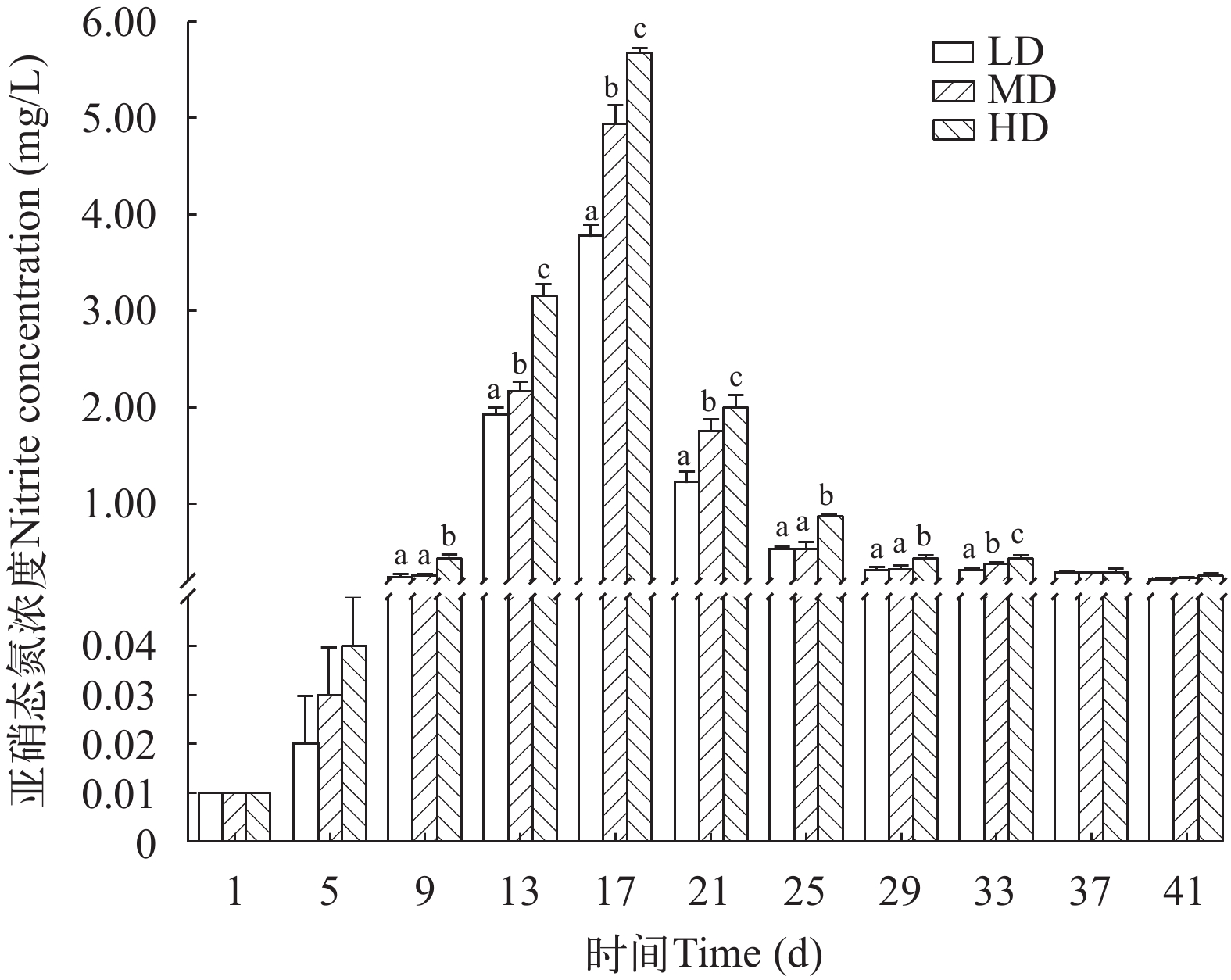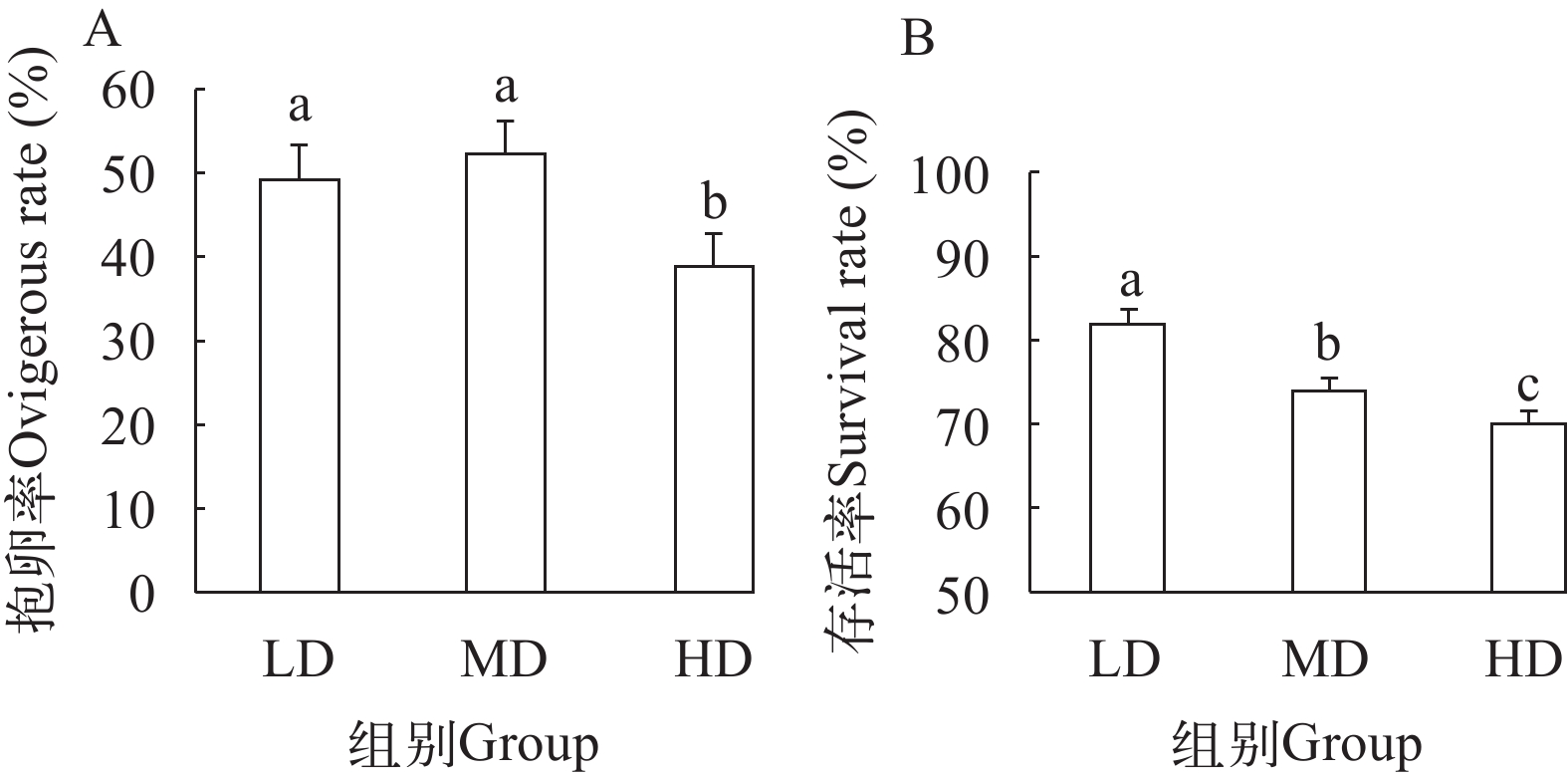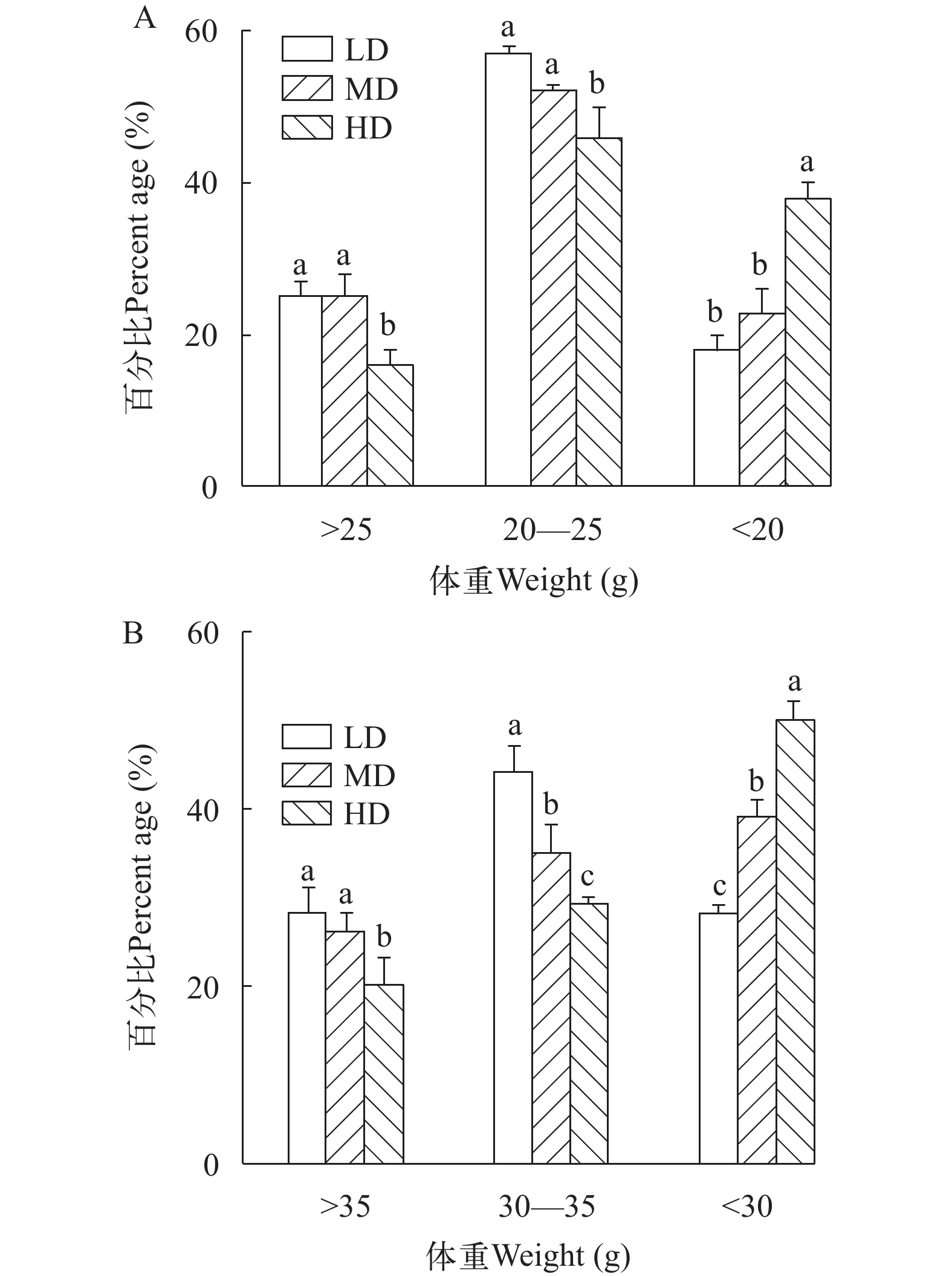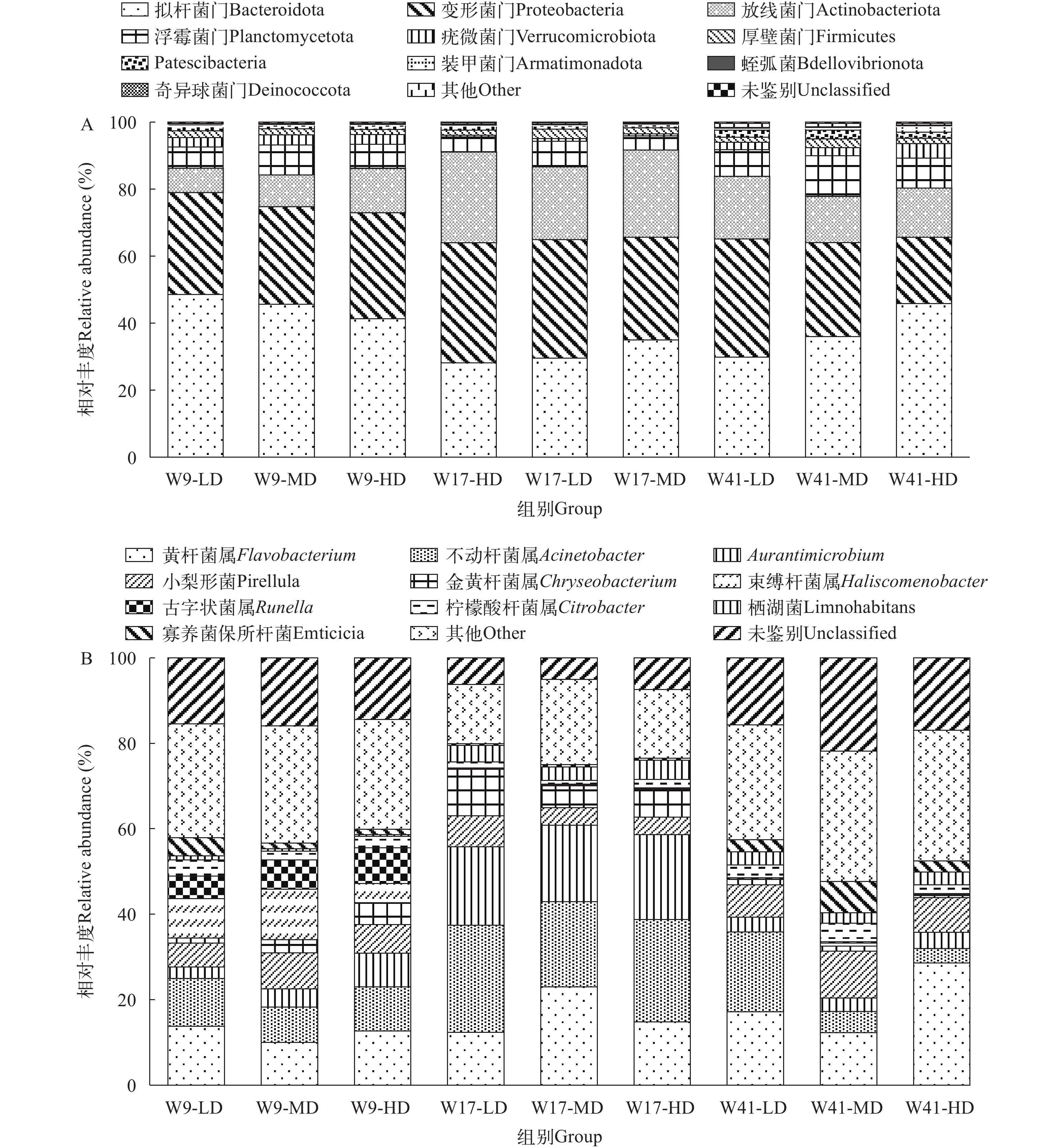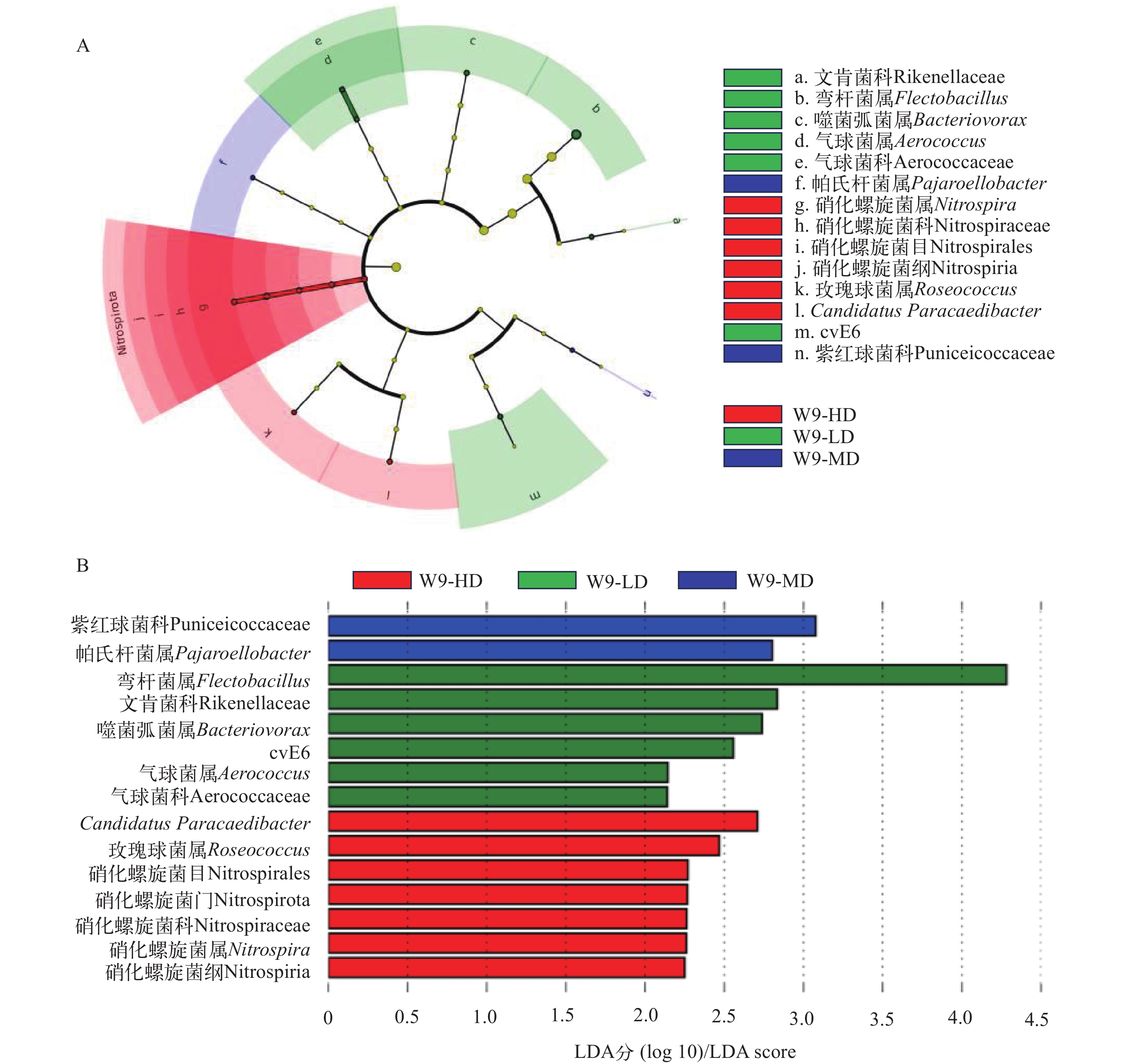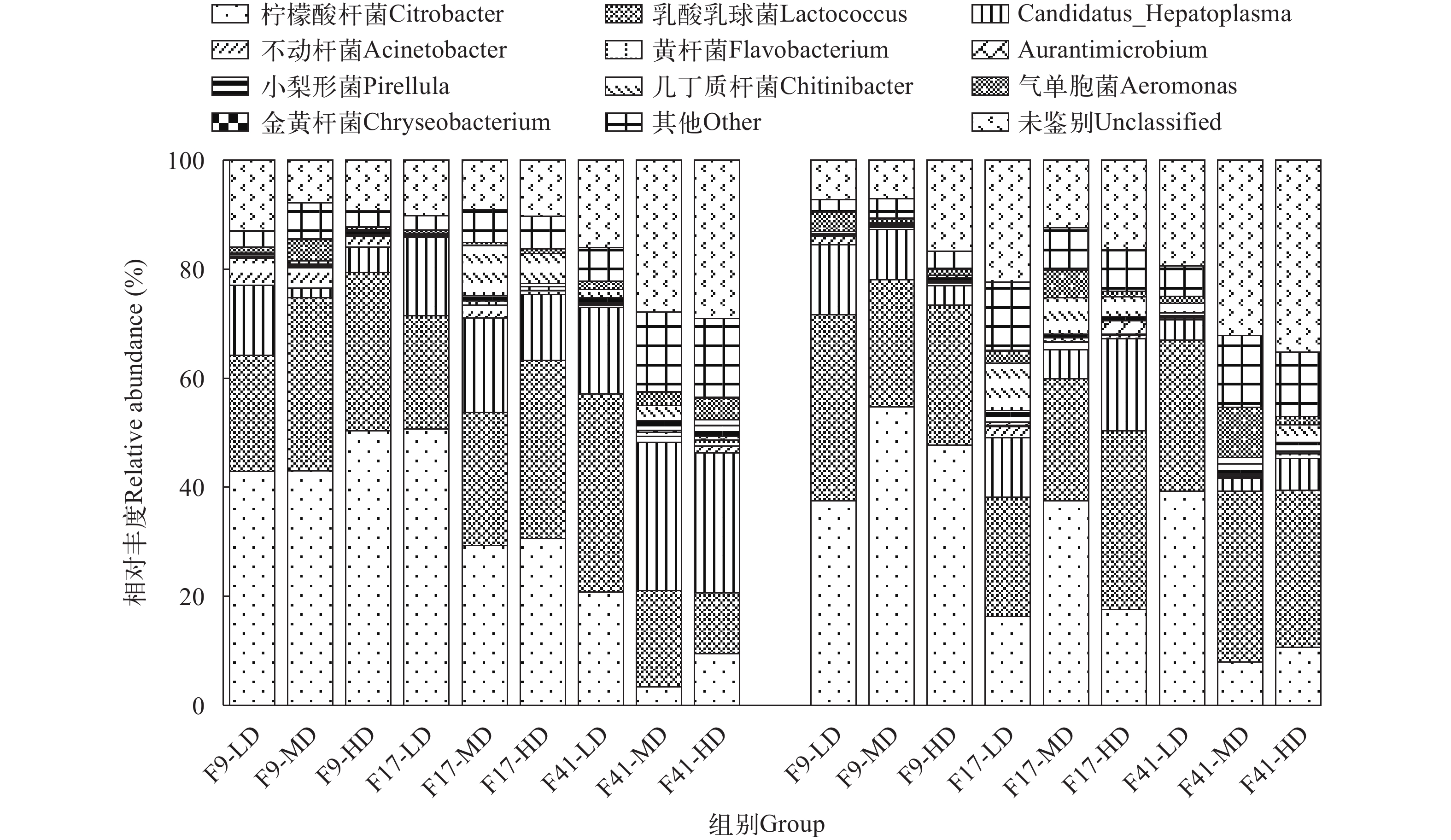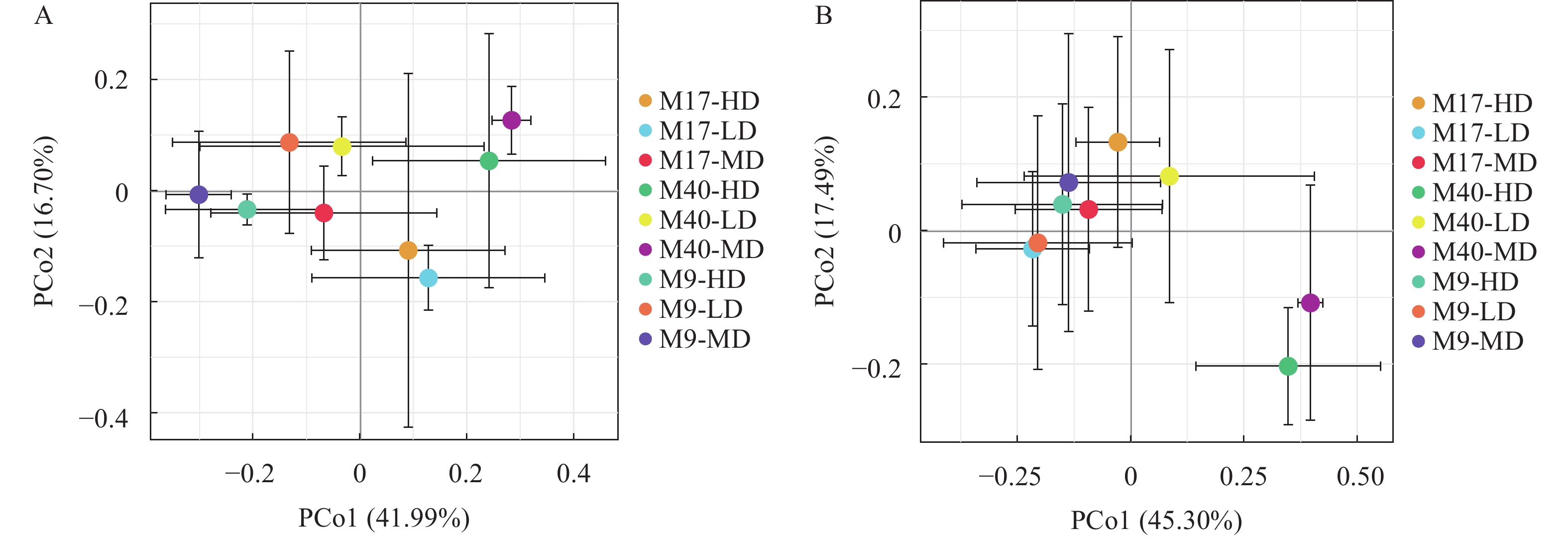DENSITY ON THE SURVIVAL RATE, OVULATION RATE, WATER QUALITY, WATER, AND INTESTINAL MICROBIAL COMMUNITY OF BROODSTOCK MACROBRACHIUM ROSENBERGII
-
摘要:
为探讨保种期罗氏沼虾(Macrobrachium rosenbergii)种虾合理的放养密度, 实验以温室保种期的种虾为研究对象, 雌雄比例2﹕1, 雌虾初始体重为(17.95±1.11) g, 雄虾初始体重为(21.39±1.63) g, 设置3个放养密度: LD (1.0 kg/m3)、MD (1.5 kg/m3)、HD (2.0 kg/m3), 研究了密度对罗氏沼虾种虾抱卵率、存活率、水质、水体和肠道微生物群落的影响。结果表明: 水质未稳定前, 水体中氨氮和亚硝态氮的含量随着放养密度的增加而升高, HD组显著高于LD组(P<0.05)。水质稳定后各密度组之间无显著差异(P>0.05)。LD组和MD组雌虾的抱卵率显著大于HD组(P<0.05), LD组和MD组无显著差异(P>0.05)。存活率随着放养密度的增加显著降低(P<0.05)。放养密度显著影响罗氏沼虾的规格, 小规格虾的比例随着放养密度的升高显著增加(P<0.05)。水体微生物群落结果表明, 水体中氨氮含量最高时, 硝化螺旋菌属(Nitrospira)为HD组的指示物种。肠道微生物结果表明, 在相同的采样时间, 放养密度对罗氏沼虾肠道微生物菌群组成无显著影响。但当水体中氨氮含量最高时, 潜在病原菌柠檬酸杆菌(Citrobacter)的占比在MD组和HD组有所升高, 说明密度引起的水质变化显著影响中高密度组的肠道微生物群落组成。综上, 建议保种期罗氏沼虾的放养密度以1.0 kg/m3为宜。
Abstract:This study aims to investigate the appropriate stocking density for broodstock Macrobrachium rosenbergii. The experiment was conducted in a greenhouse setting, using M. rosenbergii broodstock with a sex ratio of 2﹕1 (females to males). The initial weight of the female shrimps was (17.95±1.11) g, and the male shrimp weighed (21.39±1.63) g. Three stocking densities were tested: LD (1.0 kg/m3), MD (1.5 kg/m3), and HD (2.0 kg/m3). The effects of these stocking densities on brooding rate, survival rate, water quality, and microbial communities in both water and the shrimp gut were analyzed. The results showed that before water quality stabilized, ammonia nitrogen and nitrite nitrogen levels increased with higher stocking density, with the HD group exhibiting significantly higher levels than the LD group (P<0.05). After stabilizing the water quality, no significant differences were observed among the density groups (P>0.05). The ovulation rate of female shrimp in the LD and MD groups was significantly higher than that in the HD group (P<0.05), while there was no significant difference between the LD and MD groups (P>0.05). Survival rate decreased significantly as stocking density increased (P<0.05). Meanwhile, stocking density had a notable effect on the size distribution of broodstock M. rosenbergii, with a significantly higher proportion of smaller shrimp in the higher density groups (P<0.05). Gut microflora results showed that stocking density had no significant effect on bacterial community composition at any sampling time. However, at the peak of ammonia nitrogen content, the proportion of potentially pathogenic Citrobacter increased in both MD and HD groups, indicating that water quality changes caused by higher density significantly influenced the gut microbiota composition in these groups. In conclusion, a stocking density of 1.0 kg/m3 was suggested as the most suitable for broodstock M. rosenbergii. The results of this study provide a valuable reference for determining the appropriate stocking density for M. rosenbergii.
-
作为水产养殖重要的影响因子, 养殖密度可以影响养殖水质、养殖对象的生长、存活率、消化酶活力、机体抗氧化能力、肠道微生物群落等因子, 进而影响水产动物的养殖产量和经济效益[1, 2]。有关养殖密度对水产动物的影响的研究较多, 已涉及大菱鲆(Scophthalmus maximus)[3]、罗非鱼(Oreochromis niloticus)[4]、虹鳟(Oncorhynchus mykiss)[5]、鲟(Acipenser baerii)[6]、大口黑鲈(Micropterus salmoides)[7]等众多品种。在甲壳动物方面, 有学者研究了密度对红螯螯虾(Cherax quadricarinatus)[8—10]、凡纳滨对虾(Litopenaeus vannamei)[11—14]、克氏原螯虾(Procambarus clarkii)[15, 16]、斑节对虾(Penaeus Monodon)[17, 18]等品种的生长性能、养殖效益和抗病性等的影响, 提出了不同养殖模式下适宜的养殖密度, 为以上品种的健康养殖提供了科学参考。合理提高养殖密度可以提高水体利用率, 获得较高的养殖产量和经济效益, 但是过高的养殖密度会作为慢性应激因子, 导致养殖动物生长性能和免疫功能下降, 引起氧化损伤, 甚至造成病害暴发, 给养殖带来负面影响[19]。因此, 合理的密度是保证养殖动物福利, 获得最佳经济效益的重要前提。
罗氏沼虾(Macrobrachium rosenbergii)属十足目、长臂虾科、沼虾属, 又名马来西亚大虾, 2022年全国养殖产量19.64万吨(2024中国渔业统计年鉴), 是我国重要的淡水养殖经济虾类。罗氏沼虾适宜的放养密度已有报道, Rahman等[20]研究了不同放养密度对全雌罗氏沼虾生长的影响, 结果表明, 密度和罗氏沼虾生长负相关, 全雌罗氏沼虾的放养密度为40.8 g/m2时, 生长最快。Siddiqui等[21]以1.8 g的罗氏沼虾幼虾为研究对象, 经过168d的养殖, 发现密度最低组生长最快, 饲料转化率最高, 而且放养密度越低, 罗氏沼虾生长越快, 大规格虾的比例越高[22, 23]。已报道的罗氏沼虾密度研究都以快速生长期的幼虾为研究对象, 围绕单性养殖、混合养殖等模式开展了适宜养殖密度的探究, 但是对罗氏沼虾种虾适宜培育密度未见报道。生产上罗氏沼虾种虾的培育密度一般凭借生产经验, 各育苗企业的放养密度均不相同, 培育出的种虾质量不一。种虾质量作为罗氏沼虾苗种繁育的基础保障, 关乎到育苗的成败, 因此, 本研究以罗氏沼虾种虾为研究对象, 结合规模化的生产试验, 探究了罗氏沼虾种虾适宜的培育密度, 为营养强化阶段种虾密度的合理设置提供理论参考。
1. 材料与方法
1.1 实验设计
实验在浙江省淡水水产研究所综合试验基地的保种温室中进行。养殖用水泥池面积18 m2, 水深0.75 m, 养殖水体13.5 m3, 每个水泥池中放置等量的隐蔽物, 水泥池两端拉网片以供罗氏沼虾栖息。每个养殖池配有面积1.2 m3的生物滤池和养殖池形成内循环。试验设置3个放养密度: 1.0 (LD)、1.5 (MD)和2.0 kg/m3 (HD), 每个密度设置3个平行, 放养重量分别为LD组13.50 kg、MD组20.25 kg、HD组27.0 kg。实验对象为本单位自繁自育的罗氏沼虾种虾, 雌虾的初始体重为(17.95±1.11) g, 雄虾的初始体重为(21.39±1.63) g, 雌雄比例为2﹕1。
1.2 养殖管理
试验从2023年10月5日开始, 至2024年1月15日结束, 分为两个阶段, 第一阶段为种虾强化期(2023年10月5日至12月27日), 强化期间, 雌雄分开, 水温24℃, 每天每个种虾池吸污换水10 cm, 每天早晚投喂罗氏沼虾种虾饲料2次, 投喂量为虾体总重的1%左右, 每周搭配投喂鱿鱼和胡萝卜各1次, 鱿鱼投饲率为3%, 胡萝卜投饲率为6%。第二阶段为交配期(12月28日至1月15日), 期间水温升高至28℃, 养殖管理和强化期相同。试验期间溶解氧含量在7.0 mg/L以上, pH 7.3—7.8。试验结束将水位降至15 cm, 统计虾总数和抱卵虾数。
1.3 样品采集
每隔4天采集养殖池的水样, 测定氨氮和亚硝态氮的浓度, 直至氨氮和亚硝态氮降至最低且保持稳定。根据测定结果, 分别采集水体中氨氮峰值点(9d)、亚硝态氮峰值点(17d)、水质稳定后(41d)的水样, 保存在无菌采水袋中, 经0.22 μm的无菌滤膜过滤, 滤膜保存在–80℃冰箱, 用于后续微生物群落分析。随机采集保种9d、17d和41d的罗氏沼虾, 鉴别雌雄, 无菌方式取肠道样本, 每个保种池随机取10只虾的肠道样本混为1管, 保存在无菌EP管中, 用于肠道微生物群落分析。在实验结束后, 统计各组的抱卵率和存活率。在挑完抱卵虾后, 每个池子随机选取雌雄虾罗氏沼虾各100只, 电子天平称量体重, 统计不同规格虾的数量。各指标计算公式:
抱卵率(%)=抱卵虾数量/雌虾总数×100
存活率(%)=实验末罗氏沼虾的数量/初始罗氏沼虾的数量×100
不同规格虾的比例(%)=对应规格范围内虾的总数/虾的总数×100
1.4 样品分析
水质指标测定 水温、溶解氧和pH采用哈希多参数水质测定仪测定(HQ40d), 氨氮采用纳氏试剂分光光度法测定(HJ535-2009), 亚硝态氮采用分光光度法测定(GB7493-87)。
细菌群落分析 参照基因组DNA提取试剂盒的方法提取样品基因组DNA(OMEGA Biotech, 美国), 利用带有barcode的特异引物341F (5′-CCTACGGGNGGCWGCAG-3′)和806R (5′-GGACTACHVGGGTWTCTAAT-3′)扩增16S rDNA的V3和V4区, 将纯化后的扩增产物连接测序接头, 构建测序文库, Illumina测序, 测序委托广州基迪奥生物科技有限公司进行。
1.5 数据分析
采用Origin2021软件进行数据整理, 制作水质变化柱状图。Excel软件制作细菌群落组成柱状图, LEFse分析、PCoA图采用基迪奥生物科技有限公司的在线云平台完成(www. omicsmart.com)。采用SPSS27.0统计软件进行显著性分析, 采用单因素方差分析(One-way ANOVA)中Duncan多重比较检验显著性, P<0.05为差异显著。
2. 结果
2.1 放养密度对水质的影响
不同密度组水体中氨氮的浓度先升高后降低最后趋于稳定, 各组在强化后9d达到峰值, 强化后5—17d, 水体中氨氮的含量随着放养密度的增加而升高, HD组显著高于LD组(P˂0.05)。在21d后, 氨氮浓度降至0.3 mg/L左右, 且保持稳定, 各组之间无显著差异(P>0.05; 图 1)。亚硝态氮的变化趋势和氨氮相似, 各组在强化第17天达到峰值, 在9—33d, 亚硝态氮的浓度随着放养密度的增加而升高, HD组显著高于LD组(P˂0.05)。37d后, 亚硝态氮趋于稳定, 各组之间无显著差异(P>0.05; 图 2)。
2.2 放养密度对罗氏沼虾抱卵率和存活率的影响
放养密度从1.0增加至1.5 kg/m3, 雌虾的抱卵率从49.03%增加至51.97%, 两组之间无显著差异(P>0.05), 进一步增加放养密度至2.0 kg/m3, 抱卵率显著降低(P˂0.05; 图 3A)。存活率随着放养密度的增加显著降低(P˂0.05), LD组的存活率最高, 为81.85%, HD组最低, 为69.88% (图 3B)。
2.3 放养密度对罗氏沼虾规格的影响
3种不同规格的雌虾在LD组和MD组的比例无显著差异(P>0.05), 体重在20—25 g的雌虾在各组的占比最高, LD组和MD组显著高于HD组(P˂0.05)。体重<20 g的雌虾的比例随着放养密度的增加而升高, HD组的占比为38%, 显著高于其他两组(P˂0.05; 图 4A)。在雄虾中, 体重大于35 g的雄虾的比例随着放养密度的增加而减小, HD组显著低于LD和MD组(P<0.05); 体重在30—35 g的雄虾的比例则随着放养密度的增加显著降低(P<0.05), 而体重<30 g的雄虾比例则随着放养密度的增加显著升高(P<0.05; 图 4B)。
2.4 放养密度对养殖水体和肠道细菌群落组成的影响
在门水平, 各密度组水体中的优势菌相同, 主要包括拟杆菌门(Bacteroidota)和变形菌门(Proteobacteria), 相对丰度之和在60%以上(图 5A)。在属水平, 保种9d, LD组、MD组和HD组水体中微生物群落组成相似, 主要由黄杆菌(Flavobacterium)、不动杆菌属(Acinetobacter)、小梨形菌属(Pirellula)、束缚杆菌属(Haliscomenoba)、古字状菌属(Runella)等组成, 丰度之和分别为39.75%、38.56%和37.54%; 保种17d, 水体中的细菌除黄杆菌外, 不动杆菌属和黄色细菌属(Aurantimicrobium)的相对丰度有所增加, 逐渐成为水体的优势菌。保种41d, 不同密度组水体的细菌组成有所不同, 黄色细菌属相对丰度降低, 细菌群落主要由黄杆菌属、不动杆菌属和小梨形菌属组成(图 5B)。
![]() 图 5 不同密度组水体的细菌群落组成A表示门水平; B表示属水平; W9、W17、W41表示保种9d、14d和41d的水样; LD、MD、HD表示1.0、1.5和2.0 kg/m3组; 下同Figure 5. Community composition of microbes in different density groups of M. rosenbergiiA represents phylum level, B represents genus level; W9, W17, and W41 mean water samples of the 9th, 14th, and 41st days of preservation; LD, MD, and HD indicate the 1.0, 1.5 and 2.0 kg/m3 group respectively; the same applies below
图 5 不同密度组水体的细菌群落组成A表示门水平; B表示属水平; W9、W17、W41表示保种9d、14d和41d的水样; LD、MD、HD表示1.0、1.5和2.0 kg/m3组; 下同Figure 5. Community composition of microbes in different density groups of M. rosenbergiiA represents phylum level, B represents genus level; W9, W17, and W41 mean water samples of the 9th, 14th, and 41st days of preservation; LD, MD, and HD indicate the 1.0, 1.5 and 2.0 kg/m3 group respectively; the same applies below2.5 不同密度组养殖水体细菌群落差异物种分析
LEFse分析可以筛选出组间的主要差异菌群(图 6A)。将筛选出的差异菌群使用LDA (Linear Discriminant Analysis)得出的结果进行排序, 设置门槛值大于2.0 (图 6B)。LEFse分析结果表明, 在保种9d, LD组LDA得分排名前3名的指示物种分别为弯杆菌属(Flectobacillus)、Flectobacillus_roseus属和文肯菌科(Rikenellaceae), MD组的指示物种为紫红球菌科(Puniceicoccaceae)和帕氏杆菌属(Pajaroellobacter), Cytophaga_sp_VM1T种, 而硝化螺旋菌属(Nitrospira)是HD组重要的指示物种。
2.6 放养密度对罗氏沼虾肠道细菌群落组成的影响
保种9d, 雌虾肠道中的优势细菌以柠檬酸杆菌(Citrobacter)和乳球菌属(Lactococcus)为主, 相对丰度之和占60%以上, 柠檬酸杆菌的占比随着放养密度的增加有所升高。保种17d, 雌虾肠道中的优势细菌和9d相同, 柠檬酸杆菌的丰度较9d有所降低。保种41d, 雌虾肠道的优势菌群发生改变, 随着放养密度的增加, 柠檬酸杆菌和乳球菌属相对丰度之和从LD组的57.13%逐渐减少至MD组的20.97%和HD组的20.59%, 而Candidatus_ Hepatoplasma的相对丰度从LD组的15.84%逐渐增加至MD组的27.24%和HD组的25.66%。雄虾的肠道微生物群落和雌虾相似(图 7)。
![]() 图 7 不同密度组罗氏沼虾肠道菌群在属水平的组成图F表示雌虾, M表示雄虾; 9、17、41表示养殖时间; F9—LD表示保种9d时1.0 kg/m3组的雌虾; 下同Figure 7. Community composition of intestine microbes in different density groups of M. rosenbergii on genus levelF represents female shrimp, M represents male shrimp, the number of 9, 17, and 41 represent culturing time. F9—LD means female shrimp in 1.0 kg/m3, culturing 9d; the same applies below
图 7 不同密度组罗氏沼虾肠道菌群在属水平的组成图F表示雌虾, M表示雄虾; 9、17、41表示养殖时间; F9—LD表示保种9d时1.0 kg/m3组的雌虾; 下同Figure 7. Community composition of intestine microbes in different density groups of M. rosenbergii on genus levelF represents female shrimp, M represents male shrimp, the number of 9, 17, and 41 represent culturing time. F9—LD means female shrimp in 1.0 kg/m3, culturing 9d; the same applies below2.7 罗氏沼虾肠道微生物α多样性分析
罗氏沼虾肠道微生物α多样性指数见表 1。9d和17d, 雌雄虾肠道微生物群落的OTUs、Ace指数、Chao1指数和PD指数差异不显著(P>0.05), 表明保种初期至中期, 放养密度对罗氏沼虾的肠道菌群α多样性无显著影响。保种41d, 雌虾的α多样性指数随着放养密度的增加而升高, HD组显著高于LD组(P<0.05), 雄虾的α多样性指数则在MD组最高, 其中MD组的OTUs和Chao1指数显著高于LD组(P<0.05)。
表 1 罗氏沼虾肠道微生物α多样性指数表Table 1. The α diversity indices of intestinal microbial of M. rosenbergii指数-组别
Index-GroupOTUs
OTU numberAce指数
Ace indexChao1指数
Chao indexPD指数
PD indexF9-LD 368.67±153.96ab 453.85±122.55ab 446.26±129.97ab 76.45±27.66abc F9-MD 459.00±110.57ab 561.45±100.92abc 569.25±86.70abc 77.78±5.78abc F9-HD 414.00±190.49ab 512.30±196.26abc 502.71±198.44abc 64.21±22.75a F17-LD 308.33±39.27a 380.91±49.97a 379.37±57.21a 61.43±17.61a F17-MD 463.00±111.64ab 572.12±142.93abc 575.42±150.66abc 88.71±18.33abc F17-HD 416.33±52.27ab 501.06±78.10abc 500.37±61.86abc 82.29±22.19abc F41-LD 698.00±167.68cde 829.47±154.82d 825.67±179.17de 122.33±18.13d F41-MD 809.33±86.32ef 875.56±61.31de 888.23±60.96def 123.05±15.66d F41-HD 961.00±138.39f 1055.05±140.63e 1055.87±131.80f 160.52±5.75e M9-LD 397.33±87.92ab 490.50±96.76ab 486.13±98.48abc 70.68±5.87ab M9-MD 496.67±139.00ab 584.66±148.84abc 593.49±168.64abc 82.88±10.25abc M9-HD 516.33±64.79abc 626.14±22.31bc 611.09±33.49bc 85.17±10.74abc M17-LD 357.67±19.35ab 442.89±41.13ab 430.79±56.97ab 74.93±11.59ab M17-MD 407.00±74.99ab 472.55±125.97ab 471.20±112.77abc 72.96±20.33ab M17-HD 435.67±34.79ab 510.36±29.06abc 514.13±20.32abc 72.84±11.97ab M41-LD 556.67±87.13bcd 712.98±58.34cd 688.98±71.86cd 91.02±12.32abc M41-MD 799.33±132.76ef 917.02±167.07de 917.18±141.86ef 106.47±16.34cd M41-HD 731.00±103.87de 834.31±110.76d 842.62±108.03de 101.00±13.58bcd 注: 同列数据肩标相同小写字母表示差异不显著(P>0.05), 不同小写字母表示差异显著(P<0.05)Note: In the same column, values with the same lowercase letter mean no significant difference (P>0.05), while with different lowercase superscript mean significant difference (P<0.05) 2.8 罗氏沼虾肠道微生物β多样性分析
雄性罗氏沼虾肠道微生物群落的PCoA图表明(图 8A), 在相同的采样时间点, 不同密度组的微生物群落距离较近, 表明微生物群落较为相似, 其中, PCo1和PCo2对差异微生物的方差解释度之和为58.69%。雌性罗氏沼虾肠道微生群落PCoA图显示(图 8B), 41d的MD组和HD组和其他组分开, 肠道菌群和其他组有所差异, 其中PCo1和PCo2对差异微生物的方差解释度之和为62.79%。
基于weighted-unifrac距离, 在OTU水平对样本进行Adonis检验(图 9)。MD组雄虾的肠道菌群在不同的采样时间点表现出显著性差异, 即M9-MD、M17-MD和M40-MD组间差异显著(图 9A)。对组间差异进行检验, 和雄虾类似, MD组雌虾的细菌群落在不同的采样时间呈现显著性差异(图 9B), 此外, 在不同的采样时间点, HD组的雌虾肠道细菌群落组成(F9-HD、F17-HD和F40-HD)差异显著(图 9C)。
3. 讨论
3.1 密度对罗氏沼虾种虾养殖水质和水体微生物群落的影响
水质是水产养殖的关键, 氨氮和亚硝态氮是水环境的主要污染因子, 水体中高浓度的氨可经渗透进入到水产动物体内, 增加组织耗氧量, 降低血细胞的携氧能力, 导致中毒症状发生[24—26]。增加养殖密度会导致水体中氨氮和亚硝态氮浓度升高, 如倪蒙等[27]探讨了不同养殖密度对罗氏沼虾苗种(0.61 g)池塘水质的影响, 结果表明高密度组(60.0 ind./m2)水体中的氨氮和亚硝态氮含量显著高于中低密度组。陈亚坤等[28]的研究表明, 随着放养密度的增加, 凡纳滨对虾养殖水体氨氮含量上升, 本研究结果表明, 养殖前期, 水体中氨氮和亚硝态氮的浓度随着放养密度的升高而显著升高, 说明放养密度显著影响水体氨氮和亚硝态氮含量, 和以上研究结果一致。本研究中的罗氏沼虾来自池塘, 从外塘转移至温室水泥池进行养殖, 未进虾前, 水泥池中的养殖用水为超滤水, 水体中细菌数量较低, 细菌群落尚未稳定, 分解污染物的微生物菌群还未形成, 放养密度越高, 投饵量越大, 水体中剩余的残饵、粪便及虾体残肢等分解导致氨氮和亚硝态氮升高。
在水生生态系统中, 细菌是有机物分解矿化、C、N、P等营养元素转化及污染物降解的主要参与者[29], 随着氨氧化细菌的出现, 氨氮逐渐被转化为亚硝态氮, 之后出现的硝化细菌可以降解亚硝态氮, 防止亚硝态氮浓度的增加, 从而起到净化水体的作用[30]。养殖后期, 氨氮和亚硝态氮的浓度不受本实验设置的3个放养密度的影响, 这可能和水体中细菌群落逐渐稳定, 硝化细菌的出现及丰度增加密切相关。保种9d, HD组水体中氨氮含量最高, 硝化螺旋菌是HD组水体微生物群落的指示物种, 其相对丰度高于其他两组, 表明HD组的养殖水体需要培养更多的硝化细菌, 以提高硝化作用, 从而降低氨氮和亚硝态氮的累积效应, 这一结果也与水质数据相呼应。硝化螺旋菌属作为目前已发现的亚硝酸盐氧化菌(NOB)类群中系统发育最为多样的细菌, 来自于硝化螺旋菌门(Nitrospirae), 包含至少6个系统发育谱系, 之前认为硝化螺菌属只负责将亚硝酸盐转化为硝酸盐, 但近年的研究发现, 硝化螺菌属可以将氨氮完全氧化为硝酸盐, 在氮转化过程中发挥着重要作用[31—33]。本试验在高密度组养殖水体中发现了丰度较高的硝化螺旋菌, 可能是为了清除水体中积累过多的氨氮和亚硝态氮, 使养殖后期水体中的氨氮和亚硝态氮保持在较低水平。
3.2 密度对罗氏沼虾种虾存活率和抱卵率的影响
密度是影响水产动物存活率的重要因素之一[34], 已有研究表明, 密度作为一种慢性应激因子, 增加放养密度会降低水产动物的存活率[35—37]。这已经在三疣梭子蟹[38]、鲶[39]、欧洲牡蛎[40]、凡纳滨对虾[13]等品种中被证实。Rahman等[20]研究了不同放养密度对全雌罗氏沼虾幼虾存活率的影响, 结果发现, 当密度从20.8增加到161.6 g/m2, 罗氏沼虾的存活率从83.3%降低至36.5%, 和本研究结果一致。密度影响甲壳动物的存活率和众多因素有关, 如水质、生存空间挤压、争斗、生理状态等。本研究结果显示, HD组罗氏沼虾的存活率显著降低, 可能和养殖前期水质较差(氨氮和亚硝态氮含量显著升高)、生存空间受到挤压, 种虾争斗加剧有关。此外, 也有报道指出, 放养密度会对养殖对象的免疫系统和生理状态造成负面影响, 从而导致生长性能下降、患病风险增加、存活率降低[41—43]。有关放养密度对罗氏沼虾种虾免疫和生理生化的影响还需进一步研究。
性腺发育对种虾培育至关重要, 此时大部分的能量都被分配用以性腺成熟。Rahman等[20]探讨了密度对初始规格约5 g的全雌罗氏沼虾幼虾性腺发育的影响, 结果表明, 密度对性腺指数和卵巢发育时期无显著影响, 但是增加放养密度会导致性腺发育不同步性增加, 密度越高, 早期发育的卵巢占比越高, 第一次性成熟时间越早。Cohen 等[44]对罗氏沼虾的研究结果表明, 抱卵虾的比例会随着放养密度的升高而增加。本研究结果发现, 当放养密度增加到1.5 kg/m3, 罗氏沼虾的抱卵率有所提高, 这和Cohen等[44]的研究结果相似。但是当放养密度进一步增加至2.0 kg/m3, 罗氏沼虾的抱卵率显著降低, 说明放养密度超过一定的阈值, 会对抱卵率产生不利影响。Levyl等[45]研究了在池塘养殖条件下, 密度对快速生长期罗氏沼虾抱卵率的影响, 结果发现, 放养密度越低, 大规格的罗氏沼虾占比越高, 规格越大越有利于增加交配的成功率, 抱卵率也越高。本试验的研究对象为罗氏沼虾种虾, 规格较大, 虽然已经过了快速生长期, 但是经过90d的养殖, 仍然在高密度组发现了较高比例的小规格虾(图 4), HD组的抱卵率显著降低可能是因为高密度抑制了罗氏沼虾的生长, 小规格的虾不利于交配, 导致HD组抱卵率显著降低, 有关规格和抱卵率的具体关系有待进一步研究。此外, 在本实验设置的高密度(2.0 kg/m3)条件下, 罗氏沼虾存活率显著降低, 群体数量的减少也导致了抱卵率的降低。
3.3 密度对罗氏沼虾肠道微生物菌群结构的影响
已有研究表明, 密度对水产养殖动物肠道微生物菌群具有重要影响, 密度通过影响水质、消化酶活性和抗氧化能力等影响养殖对象肠道菌群的组成[7, 46]。本实验利用16S rDNA高通量测序技术对3个采样时间点罗氏沼虾种虾的肠道微生物菌群结构进行了分析, 当水质发生改变时, 不同密度组罗氏沼虾的肠道微生物群落发生了明显的改变。如在保种9d, 水体中氨氮含量最高, 在雌虾肠道中, 柠檬酸杆菌属和乳球菌属为肠道的优势细菌, 其中, 潜在病原菌柠檬酸杆菌的相对丰度随着放养密度的增加有所升高, 这和团头鲂[47]、凡纳滨对虾[48]等肠道中潜在病原菌的丰度随着密度的增加而升高的结果一致。保种41d, 水质稳定, 罗氏沼虾肠道中柠檬酸杆菌的比例显著降低, 以上结果说明, 养殖密度通过影响养殖水质, 间接影响了罗氏沼虾的肠道微生物菌群结构, 在罗氏沼虾越冬期, 应加强水质管理、选择合理的放养密度。
3.4 不同性别的罗氏沼虾肠道微生物菌群结构差异
为进一步探究不同性别的罗氏沼虾肠道菌群结构的差异, 本试验对雌雄虾样品进行了区分, 进行16S rDNA高通量测序分析。结果显示, 保种前期(9d和17d), 雌性和雄性具有相同的优势菌群, 且细菌丰度随水质变化在雌雄虾中显示出一致的变化趋势, 说明保种前期性别对罗氏沼虾肠道菌群结构无显著影响。谢梦琪[49]研究了性别对克氏原螯虾肠道菌群的影响, 结果表明, 不同性别间克氏原螯虾肠道菌群结构没有显著性差异, 和本研究结果一致。然而在保种41d, 雌虾肠道菌群发生改变, 优势菌柠檬酸杆菌属的比例降低, 而Candidatus_Hepatoplasma的相对丰度逐渐增加。徐静静等[50]研究发现, Candidatus_Hepatoplasma 是中华绒螯蟹雌蟹(Eriocheir sinensis)抱卵前后肠道的主要菌群。在本实验中, 随着保种时间的延长, 种虾营养得到加强, 为即将开始的交配做准备, 肠道菌群中Candidatus_Hepatoplasma丰度的升高可能和本次取样的罗氏沼虾处于即将交配的阶段密切相关。此外, 尽管采样时所选样本均未抱卵, 但在前期池塘养殖和温室培育过程中, 雌虾仍可能存在抱过卵的情况, 这也可能影响雌虾的肠道菌群结构。有关罗氏沼虾雌虾抱卵前后肠道菌群的结构、差异及功能预测需要进一步深入探究。
4. 结论
本研究以罗氏沼虾种虾为研究对象, 探讨了保种期放养密度对种虾存活率、抱卵率、水质和肠道微生物菌群的影响, 结果表明, 保种前期水质较差, 增加放养密度会导致肠道潜在病原菌柠檬酸杆菌属丰度上升, 密度超过1.0 kg/m3, 存活率显著下降, 密度为1.0—1.5 kg/m3时, 抱卵率最高。综上, 建议保种期罗氏沼虾种虾的放养密度以1.0 kg/m3为宜。
-
图 5 不同密度组水体的细菌群落组成
A表示门水平; B表示属水平; W9、W17、W41表示保种9d、14d和41d的水样; LD、MD、HD表示1.0、1.5和2.0 kg/m3组; 下同
Figure 5. Community composition of microbes in different density groups of M. rosenbergii
A represents phylum level, B represents genus level; W9, W17, and W41 mean water samples of the 9th, 14th, and 41st days of preservation; LD, MD, and HD indicate the 1.0, 1.5 and 2.0 kg/m3 group respectively; the same applies below
图 7 不同密度组罗氏沼虾肠道菌群在属水平的组成图
F表示雌虾, M表示雄虾; 9、17、41表示养殖时间; F9—LD表示保种9d时1.0 kg/m3组的雌虾; 下同
Figure 7. Community composition of intestine microbes in different density groups of M. rosenbergii on genus level
F represents female shrimp, M represents male shrimp, the number of 9, 17, and 41 represent culturing time. F9—LD means female shrimp in 1.0 kg/m3, culturing 9d; the same applies below
表 1 罗氏沼虾肠道微生物α多样性指数表
Table 1 The α diversity indices of intestinal microbial of M. rosenbergii
指数-组别
Index-GroupOTUs
OTU numberAce指数
Ace indexChao1指数
Chao indexPD指数
PD indexF9-LD 368.67±153.96ab 453.85±122.55ab 446.26±129.97ab 76.45±27.66abc F9-MD 459.00±110.57ab 561.45±100.92abc 569.25±86.70abc 77.78±5.78abc F9-HD 414.00±190.49ab 512.30±196.26abc 502.71±198.44abc 64.21±22.75a F17-LD 308.33±39.27a 380.91±49.97a 379.37±57.21a 61.43±17.61a F17-MD 463.00±111.64ab 572.12±142.93abc 575.42±150.66abc 88.71±18.33abc F17-HD 416.33±52.27ab 501.06±78.10abc 500.37±61.86abc 82.29±22.19abc F41-LD 698.00±167.68cde 829.47±154.82d 825.67±179.17de 122.33±18.13d F41-MD 809.33±86.32ef 875.56±61.31de 888.23±60.96def 123.05±15.66d F41-HD 961.00±138.39f 1055.05±140.63e 1055.87±131.80f 160.52±5.75e M9-LD 397.33±87.92ab 490.50±96.76ab 486.13±98.48abc 70.68±5.87ab M9-MD 496.67±139.00ab 584.66±148.84abc 593.49±168.64abc 82.88±10.25abc M9-HD 516.33±64.79abc 626.14±22.31bc 611.09±33.49bc 85.17±10.74abc M17-LD 357.67±19.35ab 442.89±41.13ab 430.79±56.97ab 74.93±11.59ab M17-MD 407.00±74.99ab 472.55±125.97ab 471.20±112.77abc 72.96±20.33ab M17-HD 435.67±34.79ab 510.36±29.06abc 514.13±20.32abc 72.84±11.97ab M41-LD 556.67±87.13bcd 712.98±58.34cd 688.98±71.86cd 91.02±12.32abc M41-MD 799.33±132.76ef 917.02±167.07de 917.18±141.86ef 106.47±16.34cd M41-HD 731.00±103.87de 834.31±110.76d 842.62±108.03de 101.00±13.58bcd 注: 同列数据肩标相同小写字母表示差异不显著(P>0.05), 不同小写字母表示差异显著(P<0.05)Note: In the same column, values with the same lowercase letter mean no significant difference (P>0.05), while with different lowercase superscript mean significant difference (P<0.05) -
[1] Ani J S, Manyala J O, Masese F O, et al. Effect of stocking density on growth performance of monosex nile tilapia (Oreochromis niloticus) in the aquaponic system integrated with lettuce (Lactuca sativa) [J]. Aquaculture and Fisheries, 2022, 7(3): 328-335. doi: 10.1016/j.aaf.2021.03.002
[2] Hossain M A, Hossain M A, Haque M A, et al. Determination of suitable stocking density for good aquaculture practice-based carp fattening in ponds under drought-prone areas of Bangladesh [J]. Aquaculture, 2022(547): 737485. doi: 10.1016/j.aquaculture.2021.737485
[3] Liu B L, Fei F, Li X T, et al. Effects of stocking density on stress response, innate immune parameters, and welfare of turbot (Scophthalmus maximus) [J]. Aquaculture International, 2019, 27(6): 1599-1612. doi: 10.1007/s10499-019-00413-2
[4] Zafar A, Roni M A, Rana M, et al. Growth, digestive enzyme activities, proximate composition and hemato-biochemcial responses of juvenile nile tilapia (Oreochromis niloticus) reared at various stocking densities in a recirculatory aquaculture system [J]. Journal of Applied Aquaculture, 2023, 35(4): 1179-1201. doi: 10.1080/10454438.2022.2102957
[5] Zahedi S, Akbarzadeh A, Mehrzad J, et al. Effect of stocking density on growth performance, plasma biochemistry and muscle gene expression in rainbow trout (Oncorhynchus mykiss) [J]. Aquaculture, 2019(498): 271-278. doi: 10.1016/j.aquaculture.2018.07.044
[6] Aidos L, Vasconi M, Abbate F, et al. Effects of stocking density on reared Siberian sturgeon (Acipenser baerii) larval growth, muscle development and fatty acids composition in a recirculating aquaculture system [J]. Aquaculture Research, 2019, 50(2): 588-598. doi: 10.1111/are.13936
[7] Zheng J S, Wang Z X, Pu D C, et al. Effects of stocking density on intestinal health of juvenile Micropterus salmoides in industrial aquaponics [J]. Fishes, 2023, 8(11): 555. doi: 10.3390/fishes8110555
[8] Dong Y, Jia R, Hou Y, et al. Effects of stocking density on the growth performance, mitophagy, endocytosis and metabolism of Cherax quadricarinatus in integrated rice-crayfish farming systems [J]. Frontiers in Physiology, 2022(13): 1040712. doi: 10.3389/fphys.2022.1040712
[9] Naranjo-Páramo J, Hernández-Llamas A, Vargas-Mendieta M, et al. Stochastic dynamic model analysis of the effect of stocking density on the monosex production of male redclaw crayfish Cherax quadricarinatus reared in commercial gravel-lined ponds [J]. Aquaculture, 2021(535): 736351. doi: 10.1016/j.aquaculture.2021.736351
[10] Jia R, Dong Y, Hou Y R, et al. Transcriptome analysis reveals the effect of stocking density on energy metabolism in the gills of Cherax quadricarinatus under rice-crayfish co-culture [J]. International Journal of Molecular Sciences, 2023, 24(14): 11345. doi: 10.3390/ijms241411345
[11] Deng Y, Xu X, Yin X, et al. Effect of stock density on the microbial community in biofloc water and Pacific white shrimp (Litopenaeus vannamei) gut microbiota [J]. Applied Microbiology and Biotechnology, 2019, 103(10): 4241-4252. doi: 10.1007/s00253-019-09773-4
[12] Yuan H, Xie M H, Hu N J, et al. Growth, immunity and transcriptome response to different stocking densities in Litopenaeus vannamei [J]. Fish & Shellfish Immunology, 2023(139): 108924.
[13] Irani M, Rajabi Islami H, Nafisi Bahabadi M, et al. Production of Pacific white shrimp under different stocking density in a zero-water exchange biofloc system: Effects on water quality, zootechnical performance, and body composition [J]. Aquacultural Engineering, 2023(100): 102313. doi: 10.1016/j.aquaeng.2022.102313
[14] Liu G, Zhu S, Liu D, et al. Effects of stocking density of the white shrimp Litopenaeus vannamei (Boone) on immunities, antioxidant status, and resistance against Vibrio harveyi in a biofloc system [J]. Fish & Shellfish Immunology, 2017(67): 19-26.
[15] Li J H, Qian C, Li C L, et al. Exploration of the optimal stocking density of red swamp crayfish (Procambarus clarkii) larvae by using the biofloc technology [J]. Aquaculture International, 2023, 31(3): 1569-1582. doi: 10.1007/s10499-022-01042-y
[16] Yu J X, Xiong M T, Ye S W, et al. Effects of stocking density and artificial macrophyte shelter on survival, growth and molting of juvenile red swamp crayfish (Procambarus clarkii) under experimental conditions [J]. Aquaculture, 2020(521): 735001. doi: 10.1016/j.aquaculture.2020.735001
[17] Shyne Anand P S, Balasubramanian C P, Christina L, et al. Substrate based black tiger shrimp, Penaeus monodon culture: Stocking density, aeration and their effect on growth performance, water quality and periphyton development [J]. Aquaculture, 2019(507): 411-418. doi: 10.1016/j.aquaculture.2019.04.031
[18] AftabUddin S, Siddique M A M, Sein A, et al. First use of biofloc technology for Penaeus monodon culture in Bangladesh: Effects of stocking density on growth performance of shrimp, water quality and bacterial growth [J]. Aquaculture Reports, 2020(18): 100518. doi: 10.1016/j.aqrep.2020.100518
[19] Araneda M, Pérez E P, Gasca-Leyva E. White shrimp Penaeus vannamei culture in freshwater at three densities: Condition state based on length and weight [J]. Aquaculture, 2008, 283(1/2/3/4): 13-18.
[20] Rahman M M, Salin K R, Tsusaka T W, et al. Effect of stocking density on growth performance and gonadal maturity of all-female giant freshwater prawn, Macrobrachium rosenbergii [J]. Journal of the World Aquaculture Society, 2022, 53(6): 1120-1133. doi: 10.1111/jwas.12888
[21] Siddiqui A Q, Al-Hafedh Y S, Al-Harbi A H, et al. Effects of stocking density and monosex culture of freshwater prawn Macrobrachium rosenbergii on growth and production in concrete tanks in Saudi Arabia [J]. Journal of the World Aquaculture Society, 1997, 28(1): 106-112. doi: 10.1111/j.1749-7345.1997.tb00968.x
[22] Cuvin-Aralar M L A, Aralar E V, Laron M, et al. Culture of Macrobrachium rosenbergii (De Man 1879) in experimental cages in a freshwater eutrophic lake at different stocking densities [J]. Aquaculture Research, 2007, 38(3): 288-294. doi: 10.1111/j.1365-2109.2007.01667.x
[23] Kunda M, Azim M E, Wahab M A, et al. Potential of mixed culture of freshwater prawn (Macrobrachium rosenbergii) and self-recruiting small species mola (Amblypharyngodon mola) in rotational rice–fish/prawn culture systems in Bangladesh [J]. Aquaculture Research, 2008, 39(5): 506-517. doi: 10.1111/j.1365-2109.2008.01905.x
[24] Zhang L, Pan L, Xu L, et al. Effects of ammonia-N exposure on the concentrations of neurotransmitters, hemocyte intracellular signaling pathways and immune responses in white shrimp Litopenaeus vannamei [J]. Fish & Shellfish Immunology, 2018(75): 48-57.
[25] 魏孟申, 郑涛, 路思琪, 等. 氨氮胁迫对大口黑鲈幼鱼组织结构、酶活及肠道微生物的影响 [J]. 水生生物学报, 2024, 48(1): 10-22.] doi: 10.7541/2023.2023.0054 Wei M S, Zheng T, Lu S Q, et al. Ammonia-N stress on tissue structure, enzyme activity and intestinal microbiota of Macropterus Salmoides [J]. Acta Hydrobiologica Sinica, 2024, 48(1): 10-22. [ doi: 10.7541/2023.2023.0054
[26] Edwards T M, Puglis H J, Kent D B, et al. Ammonia and aquatic ecosystems–A review of global sources, biogeochemical cycling, and effects on fish [J]. Science of the Total Environment, 2024(907): 167911. doi: 10.1016/j.scitotenv.2023.167911
[27] 倪蒙, 陈雪峰, 高强, 等. 放养密度对温棚养殖罗氏沼虾生长、生化指标、水质及养殖效益的影响 [J]. 大连海洋大学学报, 2021, 36(3): 423-429.] Ni M, Chen X F, Gao Q, et al. Effects of stocking density on growth performance, biochemical indices, water quality and economic benefits of giant freshwater prawn Macrobrachium rosenbergii in a greenhouse [J]. Journal of Dalian Ocean University, 2021, 36(3): 423-429. [
[28] 陈亚坤, 郭冉, 夏辉, 等. 密度胁迫对凡纳滨对虾生长、水质因子及免疫力的影响 [J]. 江苏农业科学, 2011, 39(3): 292-294.] doi: 10.3969/j.issn.1002-1302.2011.03.117 Chen Y K, Guo R, Xia H, et al. Effects of density stress on growth, water quality factors and immunity of Litopenaeus vannamei [J]. Jiangsu Agricultural Sciences, 2011, 39(3): 292-294. [ doi: 10.3969/j.issn.1002-1302.2011.03.117
[29] 杨佳雯, 高敏, 陈森, 等. 放养密度对日本鳗鲡夏秋两季养殖水质及营养品质的影响 [J]. 水生生物学报, 2024, 48(6): 979-990.] doi: 10.7541/2024.2023.0336 Yang J W, Gao M, Chen S, et al. Stocking density on water quality and nutritional quality of Anguilla japonica in summer and autumn [J]. Acta Hydrobiologica Sinica, 2024, 48(6): 979-990. [ doi: 10.7541/2024.2023.0336
[30] 陈旭, 梁旭方, 李姣, 等. 硝化细菌对加州鲈池塘水质影响及底质净化作用 [J]. 水生生物学报, 2020, 44(2): 399-406.] Chen X, Liang X F, Li J, et al. Study of water quality and sediment purification by nitrifying bacteria in a California perch (Micropterus salmoides) pond [J]. Acta Hydrobiologica Sinica, 2020, 44(2): 399-406. [
[31] Keuter S, Koch H, Nowka B, et al. A novel Nitrospira lineage isolated from activated sludge using elevated temperatures [J]. FEMS Microbiology Letters, 2023(370): fnad035. doi: 10.1093/femsle/fnad035
[32] Mueller A J, Daebeler A, Herbold C W, et al. Cultivation and genomic characterization of novel and ubiquitous marine nitrite-oxidizing bacteria from the Nitrospirales [J]. The ISME Journal, 2023, 17(11): 2123-2133. doi: 10.1038/s41396-023-01518-6
[33] Huang T, Xia J, Liu T, et al. Comammox Nitrospira bacteria are dominant ammonia oxidizers in mainstream nitrification bioreactors emended with sponge carriers [J]. Environmental Science & Technology, 2022, 56(17): 12584-12591.
[34] Hoseini S M, Taheri Mirghaed A, Ghelichpour M. Effects of dietary tryptophan levels and fish stocking density on immunological and antioxidant responses and bactericidal activity against Aeromonas hydrophilain rainbow trout (Oncorhynchus mykiss) [J]. Aquaculture Research, 2020, 51(4): 1455-1463. doi: 10.1111/are.14491
[35] García-Cruz E L, Yamamoto Y, Hattori R S, et al. Crowding stress during the period of sex determination causes masculinization in pejerrey Odontesthes bonariensis, a fish with temperature-dependent sex determination [J]. Comparative Biochemistry and Physiology Part A: Molecular & Integrative Physiology, 2020(245): 110701.
[36] Lin Y C, Chen J C, Chen Y Y, et al. Crowding of white shrimp Litopenaeus vananmei depresses their immunity to and resistance against Vibrio alginolyticus and white spot syndrome virus [J]. Fish & Shellfish Immunology, 2015, 45(1): 104-111.
[37] Naderi M, Keyvanshokooh S, Ghaedi A, et al. Effect of acute crowding stress on rainbow trout (Oncorhynchus mykiss): a proteomics study [J]. Aquaculture, 2018(495): 106-114. doi: 10.1016/j.aquaculture.2018.05.038
[38] 葛红星, 郭洛宇, 申欣, 等. 不同密度三疣梭子蟹混养中国明对虾、青蛤对生长、经济效益及水质的影响 [J]. 江苏海洋大学学报(自然科学版), 2023, 32(2): 1-6.] Ge H X, Guo L Y, Shen X, et al. Effects of polyculture of fenneropenaeus chinensis and Cyclina sinensis with different densities of Portunus trituberculatus on growth, economic benefits and water quality [J]. Journal of Jiangsu Ocean University (Natural Science Edition), 2023, 32(2): 1-6. [
[39] Debnath C, Dube K, Saharan N, et al. Growth and production of endangered Indian butter catfish, Ompok bimaculatus (Bloch) at different stocking densities in earthen ponds [J]. Aquaculture Research, 2016, 47(10): 3265-3275. doi: 10.1111/are.12780
[40] Zorita I, Juez A, Solaun O, et al. Stocking density effect on the growth and mortality of juvenile European flat oyster (Ostrea edulis Linnaeus, 1758) [J]. Aquaculture, Fish and Fisheries, 2021, 1(1): 60-65. doi: 10.1002/aff2.18
[41] Ellison A R, Uren Webster T M, Rey O, et al. Transcriptomic response to parasite infection in Nile tilapia (Oreochromis niloticus) depends on rearing density [J]. BMC Genomics, 2018, 19(1): 723. doi: 10.1186/s12864-018-5098-7
[42] 张龙, 曲克明, 张鹏, 等. 在循环水养殖系统中养殖密度对红鳍东方鲀应激反应和抗氧化状态的影响 [J]. 渔业现代化, 2019, 46(4): 14-23.] Zhang L, Qu K M, Zhang P, et al. Effects of the stocking density on stress response and antioxidant status of Takifugu rubripes in recirculating aquaculture systems [J]. Fishery Modernization, 2019, 46(4): 14-23. [
[43] Nga B T, Lürling M, Peeters E T H M, et al. Chemical and physical effects of crowding on growth and survival of Penaeus monodon Fabricius post-larvae [J]. Aquaculture, 2005, 246(1/2/3/4): 455-465.
[44] Cohen D, Raanan Z, Brody T. Population profile development and morphotypic differentiation in the giant freshwater prawn Macrobrachium rosenbergii (de Man) [J]. Journal of the World Mariculture Society, 1981, 12(2): 231-243. doi: 10.1111/j.1749-7345.1981.tb00298.x
[45] Levy T, Rosen O, Eilam B, et al. All-female monosex culture in the freshwater prawn Macrobrachium rosenbergii–A comparative large-scale field study [J]. Aquaculture, 2017(479): 857-862. doi: 10.1016/j.aquaculture.2017.07.039
[46] 李倩, 孙丽慧, 姜建湖, 等. 放养密度对IPRA养殖太湖鲂鲌生长、抗氧化酶及肠道微生物群落的影响 [J]. 水生生物学报, 2023, 47(3): 479-487.] Li Q, Sun L H, Jiang J H, et al. Stocking densities on growth, antioxidant enzyme activities and intestinal microbiota of hybrid of Culter alburnus (♀) × Megalobrama terminalis (♂) in IPRA system [J]. Acta Hydrobiologica Sinica, 2023, 47(3): 479-487. [
[47] Wang Y W, Zhu J, Ge X P, et al. Effects of stocking density on the growth performance, digestive enzyme activities, antioxidant resistance, and intestinal microflora of blunt snout bream (Megalobrama amblycephala) juveniles [J]. Aquaculture Research, 2019, 50(1): 236-246. doi: 10.1111/are.13889
[48] 袁航, 胡乃捷, 陈俭, 等. 养殖密度对凡纳滨对虾生长性能及其肠道消化酶和菌群结构的影响 [J]. 南方农业学报, 2023, 54(1): 289-302.] Yuan H, Hu N J, Chen J, et al. Effects of stocking density on the growth performance, intestinal digestive enzyme activities and microflora structure of Litopenaeus vannamei [J]. Journal of Southern Agriculture, 2023, 54(1): 289-302. [
[49] 谢梦琪, 张诗雨, 许荔立, 等. 不同性别和生长阶段对克氏原螯虾肠道菌群多样性的影响 [J]. 水生生物学报, 2021, 45(6): 1243-1254.] Xie M Q, Zhang S Y, Xu L L, et al. The intestinal microbiota diversities of Procambarus clarkia at different sexes and growth stages [J]. Acta Hydrobiologica Sinica, 2021, 45(6): 1243-1254. [
[50] 徐静静, 冯广朋, 陈建华, 等. 长江口中华绒螯蟹雌蟹洄游期的肠道菌群多样性 [J]. 江苏农业科学, 2021, 49(1): 146-151.] Xu J J, Feng G P, Chen J H, et al. The study of intestinal flora diversity of female Eriocheir sinensis in the Yangtze River [J]. Jiangsu Agricultural Sciences, 2021, 49(1): 146-151. [



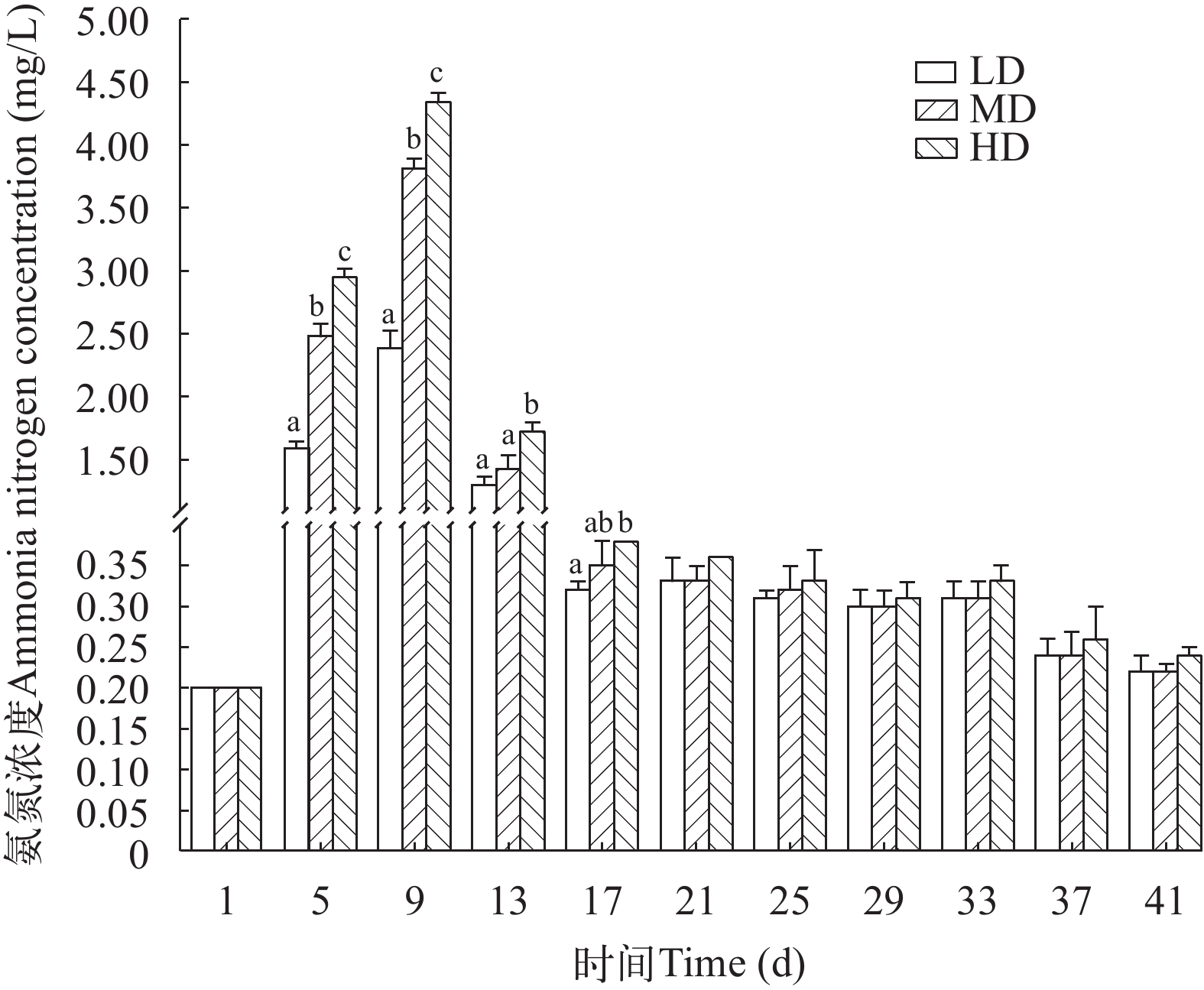
 下载:
下载:
